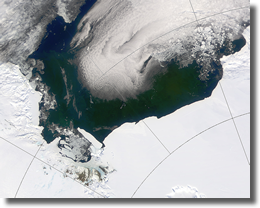IVARS: The Ross Sea
The Ross Sea, a marginal Antarctic sea south of New Zealand, has been studied since the days of the Scott/Amundsen expeditions. It is the site of extensive penguin, bird, and mammal colonies, and also the home of three significant scientific bases, McMurdo Station (US), Scott Base (New Zealand), and Stazione Baia de Terra Nova (Italy).
The Ross Sea provides a unique setting for the IVARS project. Research there during the past decades provides a background record of seasonal and year-to-year changes in basic physical and chemical processes, including the distribution of sea ice. The Sea's relatively low species diversity reduces the complexity of food-web analyses, and its pronounced spring phytoplankton bloom provides a readily observable signal.
The oceanography of the Ross Sea is relatively well known, including its physical oceanography and hydrography, nutrient concentrations, and phytoplankton biomass and species composition. However, marked variations in these variables occur spatially and temporally. Indeed, the variations with time are the greatest factor in the Ross Sea habitat. Throughout much of the austral winter (June-July) the Ross Sea is ice covered, and no sunlight is available to drive photosynthesis. In contrast, during the austral summer (Dec-Feb) sunlight is continuous, the Sea is typically ice-free, and phytoplankton blooom in large numbers.
In addition to these seasonal changes, variations among years occur in all oceanographic variables, including current velocities and direction, ice concentration, winds, and phytoplankton productivity. The causes and consequences of these interannual variations are poorly known. They are likely driven by both local and remote factors. Ice concentrations are likely controlled by the Antarctic circumpolar wave (a component of the larger Antarctic circumpolar current), and by basin-wide changes induced by El Niño. Regardless of the causes, the degree of variation among years in biological variables is unknown, and this is what IVARS seeks to explore. Ultimately IVARS researchers hope to understand not only the causes, but also the consequences to the food web of the region.

